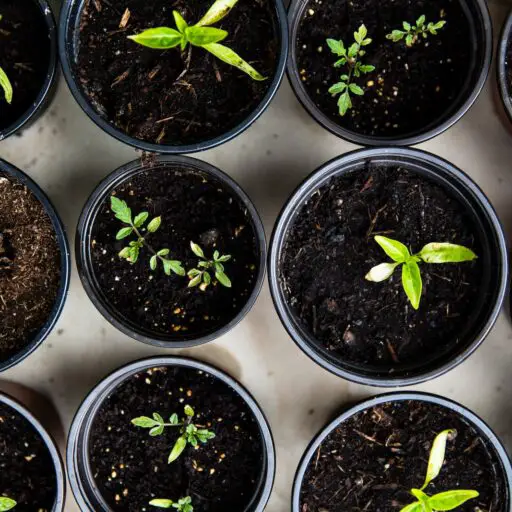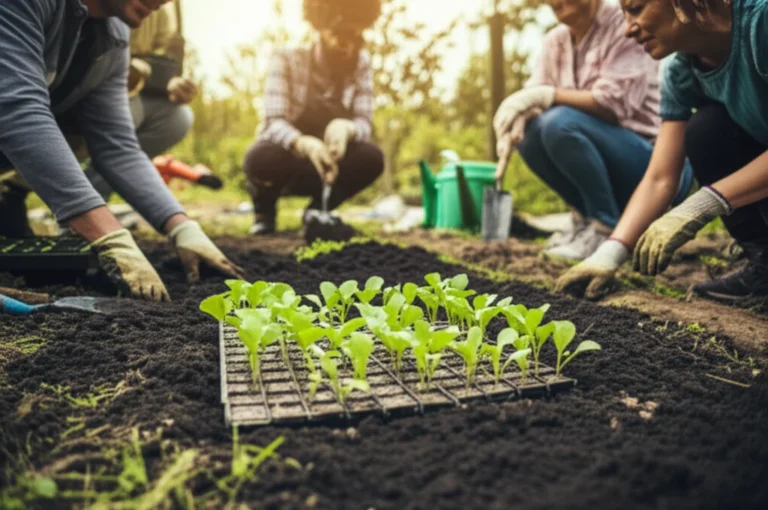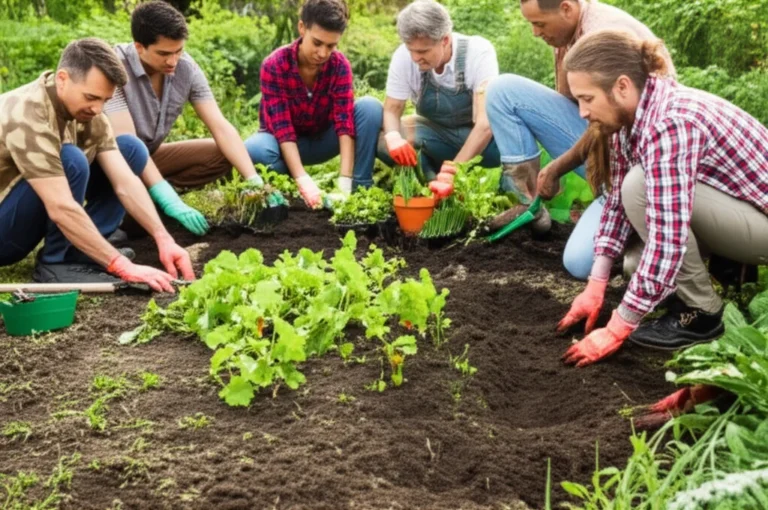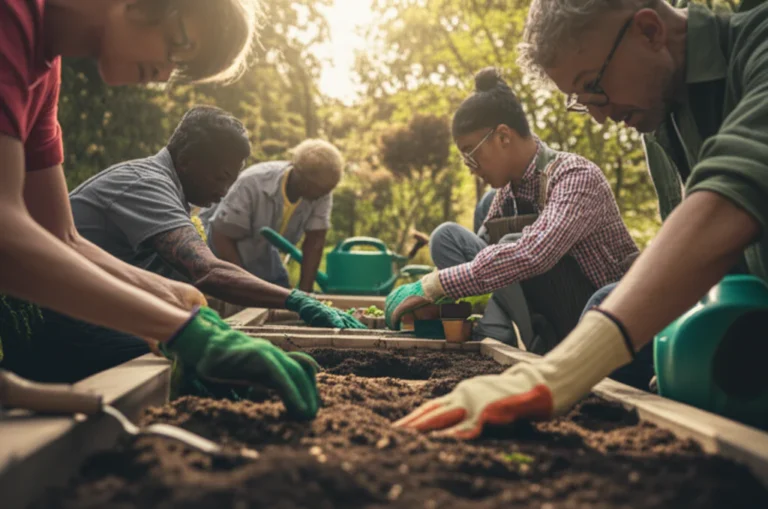Support our educational content for free when you purchase through links on our site. Learn more

Imagine turning that vacant lot down the street into a buzzing green oasis where neighbors gather, kids learn about nature, and fresh veggies flourish. Sounds like a dream? Well, it’s entirely possible—and we’re here to guide you through the 10 essential steps to create a thriving shared garden in your neighborhood this year. From scouting the perfect sunny spot to rallying your community and navigating city permits, we cover everything you need to know to transform dirt into a vibrant hub of growth and connection.
Did you know that community gardens not only boost local property values but also reduce crime rates? That’s right—gardening together literally helps neighborhoods grow safer and stronger. But how do you get started, especially if you’ve never gardened before or don’t know where to find land? Stick with us, and you’ll uncover insider tips, inspiring success stories, and practical advice to make your shared garden dream a reality.
Key Takeaways
- Find the perfect garden site by considering sunlight, water access, soil quality, and neighborhood safety.
- Engage your neighbors early to build a committed, diverse team that shares responsibilities.
- Organize with clear roles and rules to keep your garden running smoothly and inclusively.
- Design your garden thoughtfully with raised beds, accessible paths, and native plants for sustainability.
- Secure necessary permits and navigate local policies to avoid legal hurdles.
- Leverage local programs and grants like Seattle’s P-Patch or GROW Community Gardens for support.
- Use eco-friendly practices such as composting and rainwater harvesting to keep your garden green.
- Expect challenges and plan for solutions like pest control, funding gaps, and volunteer engagement.
Ready to get your hands dirty? Check out trusted gardening tools and seeds to kickstart your project:
- Fiskars Gardening Tools: Amazon | Walmart | Fiskars Official Website
- Johnny’s Selected Seeds: Amazon | Johnny’s Official
- Burpee Seeds: Amazon | Burpee Official Website
Table of Contents
- ⚡️ Quick Tips and Facts About Creating a Shared Neighborhood Garden
- 🌱 The Roots of Community Gardens: History and Neighborhood Benefits
- 🔍 Finding the Perfect Spot: How to Select a Garden Site in Your Neighborhood
- 🤝 Rallying the Troops: How to Get Neighbors Excited and Involved
- 📋 Organize Like a Pro: Setting Up Committees, Rules, and Roles
- 🎨 Designing Your Shared Garden: Layouts, Plant Choices, and Accessibility
- 🔨 Building and Growing: From Soil Prep to Planting and Maintenance
- 💡 Sustainable Practices: Eco-Friendly Tips for Your Community Garden
- 📅 Programs and Support: Leveraging Local and Citywide Gardening Resources
- 🏙️ Navigating Neighborhood Policies and Permits for Urban Gardens
- 🌿 Success Stories: Inspiring Examples of Thriving Shared Gardens
- 💬 Troubleshooting Common Challenges in Shared Gardening
- 📚 Recommended Links for Community Gardening Resources
- ❓ Frequently Asked Questions About Creating a Shared Neighborhood Garden
- 🔗 Reference Links and Further Reading
⚡️ Quick Tips and Facts About Creating a Shared Neighborhood Garden
Starting a shared garden in your neighborhood is like planting a seed that grows into a vibrant community hub 🌻. Here are some quick essentials to get you sprouting:
- Location matters: Look for sunny, accessible spots with water access. Public land is ideal but private land with a long-term lease works too.
- Gather your crew: Successful gardens thrive on diverse, committed neighbors. Aim for at least 8-10 core members to build momentum.
- Plan and organize: Define roles early—project leader, outreach coordinator, tool manager—to keep things running smoothly.
- Design with purpose: Include raised beds, compost areas, gathering spots, and accessible paths. Think about your neighborhood’s culture and needs.
- Permits and policies: Check local regulations early to avoid surprises. Many cities require permits for gardens on public land.
- Sustainability: Use recycled materials, native plants, and organic practices to keep your garden eco-friendly.
- Celebrate and educate: Host events, workshops, and invite neighbors to enjoy the space beyond just gardening.
For a deeper dive, check out our related guide on How do I start a small community garden?.
Fun fact: According to the American Community Gardening Association, community gardens can increase neighborhood property values and reduce crime rates! 🚀
🌱 The Roots of Community Gardens: History and Neighborhood Benefits
Community gardens have blossomed from humble beginnings into powerful tools for urban renewal and social connection. Let’s dig into the history and benefits that make shared gardens a neighborhood treasure:
The Story Behind the Soil
- Victory Gardens of WWII: The modern community garden movement grew from these patriotic plots, encouraging self-sufficiency.
- Urban Renewal in the 1970s: Cities like New York saw vacant lots transform into green oases, fostering community pride.
- Today’s Movement: Gardens now focus on food justice, environmental education, and social equity.
Neighborhood Perks That Grow Over Time
- Health & Nutrition: Access to fresh produce combats food deserts and promotes healthy eating.
- Social Cohesion: Shared work fosters friendships, cultural exchange, and reduces isolation.
- Environmental Impact: Gardens improve air quality, support pollinators, and manage stormwater.
- Economic Boost: They can increase nearby property values and reduce municipal maintenance costs.
Want to see the magic firsthand? The P-Patch Community Gardening Program in Seattle is a stellar example of how community gardens can transform neighborhoods.
🔍 Finding the Perfect Spot: How to Select a Garden Site in Your Neighborhood
Choosing your garden’s home is like picking the perfect plot in a treasure map. Here’s how to find a spot that will make your garden thrive:
Site Selection Criteria
| Factor | What to Look For | Why It Matters |
|---|---|---|
| Sun Exposure | Minimum 6-8 hours of direct sunlight daily | Plants need sunlight to grow healthy and strong |
| Water Access | Nearby spigot, rain barrel, or natural source | Regular watering is essential |
| Soil Quality | Test for nutrients and contaminants (lead, chemicals) | Healthy soil = healthy plants |
| Accessibility | Flat terrain, easy access for all ages and abilities | Encourages participation and maintenance |
| Visibility & Safety | Site visible to neighbors, safe from vandalism | Protects your investment and encourages community presence |
| Size | Minimum 2,000–4,000 sq ft depending on density | Enough space for beds, paths, and gathering areas |
Pro Tips from Community Gardening™ Experts
- Use city GIS maps or local land trust resources to identify vacant lots.
- Reach out to local government or nonprofits like GROW for help securing land or leases.
- Conduct soil testing through your local Cooperative Extension (e.g., UMass Soil Testing Lab) to ensure safety.
- Consider future expansion and community needs when sizing your site.
Remember, the perfect spot isn’t just about dirt and sun—it’s about community potential!
🤝 Rallying the Troops: How to Get Neighbors Excited and Involved
A garden is only as strong as the community that tends it. Here’s how to get your neighbors on board and keep them engaged:
Building Your Garden Team
- Start small: Host a neighborhood meeting or potluck to introduce the idea.
- Inclusive outreach: Use flyers, social media, local newsletters, and word of mouth. Don’t forget to reach diverse groups and language communities!
- Tap into existing groups: Partner with schools, faith groups, and community centers.
- Create roles: From tool managers to event planners, giving people responsibilities builds ownership.
- Celebrate milestones: Organize work parties, harvest festivals, or garden tours to keep enthusiasm high.
Anecdote from Our Gardeners
“We started with just five neighbors, but by hosting a spring planting party with snacks and music, we doubled our crew in one afternoon! People love to feel part of something growing.” — Community Gardening™ Team
For more on community engagement, explore our Community Garden Events section.
📋 Organize Like a Pro: Setting Up Committees, Rules, and Roles
Organization is the backbone of a thriving shared garden. Here’s how to build a structure that keeps things running smoothly:
Essential Committees and Roles
| Role | Responsibilities | Why It’s Important |
|---|---|---|
| Project Leader(s) | Coordinate with city officials, manage overall progress | Keeps the project on track |
| Outreach Team | Recruit members, communicate updates | Ensures ongoing community involvement |
| Fundraising Coordinator | Seek grants, donations, manage budget | Secures resources for garden needs |
| Work Party Leaders | Organize volunteer days | Maintains momentum and garden upkeep |
| Tool and Supply Manager | Inventory, maintenance, and distribution of tools | Keeps tools accessible and in good shape |
| Refreshments Crew | Provide snacks and drinks during events | Boosts morale and community spirit |
Creating Rules and Agreements
- Develop a garden charter outlining plot assignments, maintenance expectations, and conflict resolution.
- Decide on decision-making processes: consensus, majority vote, or leadership decisions.
- Set clear hours of operation and guest policies.
- Address liability and insurance early—some cities require it for public gardens.
Seattle’s P-Patch program offers excellent guidelines on group functioning and roles that you can adapt. Check out their Toolkit for Gardeners for inspiration.
🎨 Designing Your Shared Garden: Layouts, Plant Choices, and Accessibility
Designing your garden is like painting a living canvas. Here’s how to create a space that’s beautiful, functional, and welcoming:
Key Design Elements
- Raised beds: Easier to manage, better soil control, and accessible for all ages and abilities.
- Paths: Wide, firm, and wheelchair accessible paths encourage inclusivity.
- Water stations: Strategically placed for convenience.
- Composting area: For sustainability and soil health.
- Gathering spaces: Benches, picnic tables, or a small pavilion for community events.
- Wildlife-friendly zones: Native plants and pollinator gardens support biodiversity.
Plant Selection Tips
- Choose edible plants suited to your climate and soil, like tomatoes, kale, herbs, and beans.
- Incorporate native flowers to attract pollinators.
- Consider cultural preferences of your neighborhood to grow meaningful crops.
- Use companion planting to naturally deter pests and boost yields.
For detailed garden design ideas and inspiration, visit our Garden Design Ideas page.
🔨 Building and Growing: From Soil Prep to Planting and Maintenance
Now that you’ve planned, it’s time to get your hands dirty! Here’s a step-by-step to build and nurture your shared garden:
Step 1: Soil Preparation
- Clear debris and weeds.
- Test soil pH and nutrients; amend with compost or organic fertilizers as needed.
- Consider raised beds if soil is contaminated or poor quality.
Step 2: Construct Garden Infrastructure
- Build raised beds using rot-resistant wood like cedar or recycled materials.
- Install irrigation systems or rain barrels for water efficiency.
- Set up compost bins and tool sheds.
Step 3: Planting
- Start seeds indoors or buy seedlings from trusted nurseries like Burpee or Johnny’s Selected Seeds.
- Plant according to your design, spacing plants for airflow and growth.
- Mulch to retain moisture and suppress weeds.
Step 4: Maintenance
- Schedule regular watering, weeding, and pest monitoring.
- Rotate crops yearly to maintain soil health.
- Organize volunteer workdays to share the workload.
Our Community Gardening™ team swears by tools from Fiskars and Corona for durability and ease of use.
👉 Shop Gardening Tools on:
💡 Sustainable Practices: Eco-Friendly Tips for Your Community Garden
Want your garden to be a green champion? Here’s how to garden sustainably and leave a positive footprint:
- Composting: Turn kitchen scraps and garden waste into nutrient-rich soil amendments.
- Rainwater harvesting: Use barrels to collect rainwater and reduce municipal water use.
- Native plants: Require less water and support local wildlife.
- Organic pest control: Use companion planting, neem oil, or insecticidal soaps instead of chemicals.
- Recycled materials: Build beds and structures from reclaimed wood, pallets, or bricks.
- Pollinator habitats: Plant flowers like milkweed and coneflowers to attract bees and butterflies.
Sustainability isn’t just good for the planet—it also makes your garden more resilient and cost-effective.
📅 Programs and Support: Leveraging Local and Citywide Gardening Resources
You’re not alone in this! Many cities and organizations offer programs to support community gardens:
Examples of Support Programs
| Program Name | Services Offered | How to Access |
|---|---|---|
| P-Patch Community Gardening Program (Seattle) | Land access, design coaching, outreach support | Contact via Seattle.gov |
| Monroe County Cornell Cooperative Extension | Soil testing, pest ID, gardening advice | Visit monroe.cce.cornell.edu or call 585-753-2555 |
| Taproot Collective | Garden design, volunteer coordination | Email [email protected] |
| City of Rochester Garden Permits | Permitting, water credit program, contests | See CityofRochester.gov |
Funding Opportunities
- Neighborhood Matching Funds (varies by city)
- Grants from nonprofits like GROW Community Gardens
- Local business sponsorships and crowdfunding campaigns
Tap into these resources early to maximize your garden’s potential!
🏙️ Navigating Neighborhood Policies and Permits for Urban Gardens
Before you break ground, make sure you’re on the right side of the law. Here’s what you need to know about permits and policies:
Common Permit Requirements
- Land use permits: Required for gardens on city-owned or vacant lots.
- Change of use permits: May be necessary if the land was previously designated for another purpose.
- Water use agreements: Some cities offer water credits or require formal arrangements for water access.
- Liability insurance: Protects gardeners and the city from accidents.
How to Navigate the Process
- Contact your city’s neighborhood or parks department early.
- Review local zoning laws and environmental regulations (e.g., Environmentally Critical Areas).
- Use online GIS tools to identify available lots and restrictions (e.g., Rochester GIS Map).
- Attend public meetings or workshops to stay informed and voice community needs.
The City of Rochester’s expanded garden permit guidelines for 2025 are a great example of detailed municipal support and regulation.
🌿 Success Stories: Inspiring Examples of Thriving Shared Gardens
Nothing motivates like success! Here are some real-life stories that show what’s possible when neighbors grow together:
Morrowtown Community Garden, Burlington, NC
- Built through a partnership between Elon University and local residents.
- Features 10 raised beds, an outdoor classroom, compost piles, and a playground.
- Operates a “take-as-you-need” system to support food-insecure neighbors.
- Hosts “Mondays in Morrowtown” afterschool program for kids.
- Funded by grants and community donations; built by volunteers and students.
“It’s totally different. It’s beautiful. I’m just so thankful that there are so many people who were touched by something I said.” — Lydia Jones, community leader
Seattle’s P-Patch Program
- Over 90 community gardens citywide.
- Offers design coaching, outreach, and land access support.
- Emphasizes inclusivity, accessibility, and sustainability.
These stories prove that with passion and planning, your garden can become a neighborhood jewel!
💬 Troubleshooting Common Challenges in Shared Gardening
Even the best gardens face bumps in the road. Here’s how to tackle common issues:
| Challenge | Solution |
|---|---|
| Low participation | Host fun events, assign roles, and keep communication open. |
| Conflicts over plots | Establish clear rules and a fair plot assignment system. |
| Pests and diseases | Use organic pest control and rotate crops regularly. |
| Vandalism or theft | Improve lighting, install fencing, and engage neighbors for vigilance. |
| Water shortages | Install rain barrels and practice water-wise gardening. |
| Funding gaps | Apply for grants, host fundraisers, and seek donations. |
Our Community Gardening™ team recommends regular check-ins and a spirit of patience and collaboration. Remember, every garden has its weeds—but with teamwork, they don’t stand a chance! 🌿
📚 Recommended Links for Community Gardening Resources
- American Community Gardening Association — National resource hub for community gardening.
- P-Patch Community Gardening Program (Seattle) — Comprehensive support for community gardens.
- Monroe County Cornell Cooperative Extension — Soil testing and gardening advice.
- GROW Community Gardens — Nonprofit supporting urban gardens.
- Taproot Collective — Volunteer coordination and garden design.
- City of Rochester Garden Permits — Permitting and resources for urban gardens.
- Community Gardening™ Benefits of Community Gardens — Explore why community gardens matter.
- Community Gardening™ Garden Design Ideas — Inspiration for your garden layout.
- Community Gardening™ Edible Plants — What to grow for tasty, nutritious harvests.
❓ Frequently Asked Questions About Creating a Shared Neighborhood Garden
Q1: How do I get permission to garden on public land?
Reach out to your local parks or neighborhood department early. Many cities require permits or leases; some offer programs like Seattle’s P-Patch to guide you through the process.
Q2: What if the soil is contaminated?
Soil testing is essential. If contaminants are found, raised beds with clean soil or container gardening are safe alternatives.
Q3: How can I keep neighbors involved long-term?
Regular events, clear communication, shared responsibilities, and celebrating successes keep enthusiasm alive.
Q4: What if I don’t have gardening experience?
No worries! Many community gardens offer workshops, mentorship, and resources to help beginners thrive.
Q5: Can we grow food for donation?
Absolutely! Many gardens include “giving plots” to support local food banks or neighbors in need.
For more FAQs, visit our Community Gardening™ FAQ section.
🔗 Reference Links and Further Reading
- Seattle P-Patch Community Gardening Toolkit: https://www.seattle.gov/neighborhoods/p-patch-gardening/toolkit-for-gardeners/create-a-new-community-garden
- Elon University Morrowtown Garden Story: https://www.elon.edu/u/news/2022/05/16/community-garden-land-trust-spring-from-elon-partnership-with-burlington-neighborhood/
- City of Rochester Garden Permits and Resources: https://www.cityofrochester.gov/departments/neighborhood-and-business-development/garden-permits-city-owned-vacant-lots-0
- UMass Soil Testing Laboratory: http://ag.umass.edu/services/soil-plant-nutrient-testing-laboratory/ordering-information-forms
- American Community Gardening Association: https://communitygarden.org/
- GROW Community Gardens: https://growcommunitygardens.org/
Ready to turn your neighborhood into a blooming community paradise? Keep these insights handy, rally your neighbors, and watch your shared garden grow into a vibrant hub of life and friendship! 🌻🌿
Conclusion

Creating a shared garden in your neighborhood is more than just planting seeds—it’s about cultivating community, health, and sustainability. From selecting the perfect sunny spot to rallying your neighbors and navigating permits, every step is a chance to grow connections and green spaces that enrich lives. While challenges like soil quality, funding, and participation can arise, with thoughtful planning and teamwork, these hurdles become opportunities for creative solutions and stronger bonds.
Remember the inspiring stories from Burlington’s Morrowtown and Seattle’s P-Patch programs? They show that even small beginnings can blossom into thriving hubs of education, nourishment, and joy. By embracing inclusive design, sustainable practices, and clear organization, your shared garden can become a neighborhood jewel that keeps giving back year after year.
So, roll up your sleeves, gather your neighbors, and get ready to watch your community garden flourish—because together, we grow stronger! 🌿🌻
Recommended Links
👉 Shop Gardening Tools & Supplies:
- Fiskars Gardening Tools: Amazon | Walmart | Fiskars Official Website
- Johnny’s Selected Seeds: Amazon | Johnny’s Selected Seeds Official
- Burpee Seeds: Amazon | Burpee Official Website
Recommended Books on Community Gardening:
- The Community Garden Book by Ben Raskin — Amazon
- Growing Communities: How to Build a Community Garden That Thrives by Susan Harris — Amazon
- The Urban Farmer: Growing Food for Profit on Leased and Borrowed Land by Curtis Stone — Amazon
❓ Frequently Asked Questions About Creating a Shared Neighborhood Garden
What are the benefits of community gardening for my neighborhood?
Community gardens provide fresh, nutritious food, improve mental and physical health, and foster social connections among neighbors. They enhance local biodiversity, reduce urban heat island effects, and can even increase nearby property values. Gardens serve as educational spaces, teaching sustainable practices and cultural traditions, while promoting environmental stewardship. The collective effort also builds a sense of ownership and pride, reducing crime and improving neighborhood safety.
How do I find and organize a team of volunteers to help with a shared garden?
Start by reaching out to neighbors through flyers, social media groups, and local community centers. Hosting an initial meeting or garden kickoff event with refreshments can spark interest. Partner with schools, faith groups, and nonprofits to broaden your network. Assign clear roles such as outreach coordinator, tool manager, and event planner to give volunteers meaningful responsibilities. Keep communication open and celebrate milestones to maintain enthusiasm. Remember, diversity in your team enriches the garden’s culture and resilience.
What are the key steps to creating a successful and sustainable community garden?
- Site Selection: Choose a sunny, accessible location with water access and safe soil.
- Community Engagement: Build a diverse, committed group of gardeners and supporters.
- Organization: Establish committees, roles, and clear rules to guide operations.
- Design: Plan for accessibility, sustainability, and cultural relevance.
- Permitting: Secure necessary permits and comply with local policies.
- Building: Prepare soil, construct beds, and install infrastructure.
- Maintenance: Schedule regular care, pest management, and seasonal rotations.
- Education & Events: Host workshops and celebrations to keep the community engaged.
- Sustainability: Use eco-friendly practices like composting and rainwater harvesting.
How can I ensure that my shared garden is inclusive and accessible to all members of my community?
Design your garden with universal accessibility in mind: wide, firm paths for wheelchairs, raised beds at comfortable heights, and seating areas for rest. Use signage in multiple languages and provide tools suitable for different abilities. Engage diverse community members in planning and decision-making to reflect cultural preferences and needs. Offer flexible plot sizes and communal growing spaces to accommodate different levels of experience and time commitment. Inclusivity fosters a welcoming environment where everyone feels valued and empowered.
How do I handle soil contamination concerns in urban gardens?
Soil testing is critical before planting. If contaminants like lead or heavy metals are present, opt for raised beds filled with clean, imported soil or use container gardening. Avoid disturbing contaminated soil to prevent exposure. Consult local Cooperative Extension services or environmental agencies for testing and remediation advice. Using mulch and ground covers can also reduce dust and contact with contaminated soil.
What funding options are available for community gardens?
Funding can come from city grants (e.g., Neighborhood Matching Funds), nonprofit organizations like GROW Community Gardens, crowdfunding platforms, local business sponsorships, and in-kind donations of materials or labor. Applying for multiple small grants and hosting fundraising events can build a sustainable financial base. Keeping detailed records and demonstrating community impact helps secure ongoing support.
🔗 Reference Links and Further Reading
- Seattle P-Patch Community Gardening Toolkit: https://www.seattle.gov/neighborhoods/p-patch-gardening/toolkit-for-gardeners/create-a-new-community-garden
- Elon University Morrowtown Garden Story: https://www.elon.edu/u/news/2022/05/16/community-garden-land-trust-spring-from-elon-partnership-with-burlington-neighborhood/
- City of Rochester Garden Permits and Resources: https://www.cityofrochester.gov/departments/neighborhood-and-business-development/garden-permits-city-owned-vacant-lots-0
- UMass Soil Testing Laboratory: http://ag.umass.edu/services/soil-plant-nutrient-testing-laboratory/ordering-information-forms
- American Community Gardening Association: https://communitygarden.org/
- GROW Community Gardens: https://growcommunitygardens.org/
- Fiskars Gardening Tools: https://www.fiskars.com/en/gardening/product-categories
- Johnny’s Selected Seeds: https://www.johnnyseeds.com/
- Burpee Seeds: https://www.burpee.com/
Ready to cultivate your neighborhood’s green future? Let’s get growing! 🌿🌻





